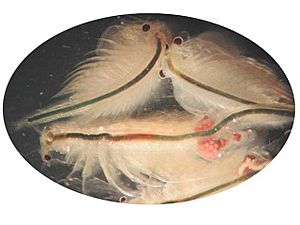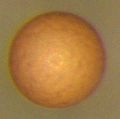Brine shrimp facts for kids
Brine shrimp are tiny shrimp that live in very salty water. They are a type of crustacea called Artemia. These amazing creatures have looked pretty much the same since the Triassic period, millions of years ago!
You can often find brine shrimp in saltwater ponds and marshes. They cannot live for long in fresh water. Brine shrimp avoid most predators, like fish, because they live in water that is too salty for most other animals. The water they like best is super salty, about 4 to 6 times saltier than the ocean! Brine shrimp usually grow to be about one centimeter long. Female brine shrimp are often a bit bigger than the males.
Contents
How Brine Shrimp Live
Brine shrimp have special body systems that work together to help them live in salty water. Their circulatory system and respiratory system help them get rid of extra salt and move oxygen around their bodies.
Breathing and Blood
Brine shrimp breathe using gills located on their feet. The oxygen they take in travels through their bloodstream. Their heart pumps blood all around their body. Brine shrimp have a protein called hemoglobin in their blood. This protein helps carry oxygen more easily to all their cells. They need hemoglobin because oxygen levels can be very low in super salty water.
Getting Rid of Salt
After taking in oxygen, their gills also pump out extra salt, water, and carbon dioxide from their bodies. They have other special glands that help pump out even more salt.
Body Structure and Movement
A brine shrimp's body has three main parts: a head, a middle section called the thorax, and a tail section called the abdomen. A hard outer shell, called an exoskeleton, covers their entire body. This exoskeleton is made of a tough material called chitin. Their muscles are attached inside this exoskeleton. Brine shrimp move by wiggling their tails and by constantly moving the many legs along their body.
Brine Shrimp Babies
Male and female brine shrimp look a little different. Males have two large antennae on their heads. These antennae are shaped like claspers and are used to hold onto the female during mating.
Eggs and Cysts
Adult female brine shrimp lay eggs about every 140 hours. If conditions are good, these eggs hatch almost right away. But if conditions are tough, like when there's not enough oxygen or the water is too salty, female brine shrimp produce special eggs inside protective cases called cysts.
These cysts are amazing! They can stay completely still and inactive for up to two years in dry, oxygen-free places, even in freezing temperatures. Brine shrimp eggs inside cysts can survive temperatures as cold as liquid air (about -190°C or -310°F). A small number can even survive temperatures above boiling (about 105°C or 221°F) for up to two hours!
Hatching and Growth
Once these cysts are placed back into normal salty water, the eggs hatch within a few hours. The baby brine shrimp, called nauplius larvae, are very tiny, less than 0.4 millimeters long when they first hatch. Brine shrimp usually live for about one year.
Images for kids
See also
 In Spanish: Artemias para niños
In Spanish: Artemias para niños





